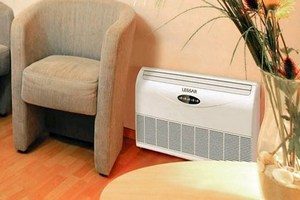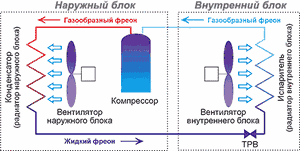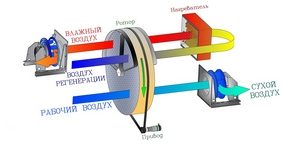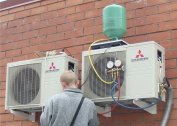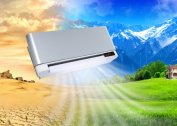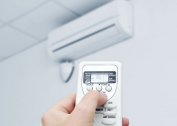Creating comfortable conditions in the house is impossible without maintaining a normal microclimate. Split air conditioning for an apartment is preferable to a monoblock. Before choosing a model, you need to determine the necessary power of the equipment, the number of rooms that are planned to be cooled, the installation site of the equipment. An important indicator is the intensity of sunlight in the room. Based on the comparison of all data, choose the appropriate model.
Purpose and type of air conditioner
The first models of air conditioners worked to cool the air in the room. New developments operate in 2 modes - cooling and heating. All equipment is divided into 2 large categories - monoblocks and split systems. Models are classified into several categories:
- place of installation;
- power;
- the presence of air heating;
- air filtration / ionization options.
Split modules consist of 2 blocks - external and internal.
Multisystems can have several indoor units at 1 outdoor. The maximum number of indoor units is 16. These models are appropriate in large multi-room apartments. Often they are installed in offices. The equipment of the air cooling system using 1 outer casing is beneficial, as the financial and labor costs of installation are reduced.
Types of multi-channel models:
- wall mounted;
- cassette
- channel;
- floor and ceiling;
- columned.
For domestic use, wall and floor-ceiling units are used. Column, channel, cassette are used on large areas in industry, commerce, in official institutions.
The principle of operation and characteristics of the split system
In the outdoor unit there is a compressor and a cooling system. A module is installed in the room with direct cooling of the room, distribution of air flow in several directions, and a control function. Purified chilled air is supplied from the outer case to the inner one. From the room, the exhaust air is discharged into the outdoor unit.
In the multisystem, several indoor modules are located in separate rooms of the apartment or in one large hall.
Advantages of split designs:
- external arrangement of the working block - noise remains outside the room;
- suspended installation frees up the space of the room;
- the ability to use several indoor units with 1 outdoor saves money on the installation of separate systems for each room;
- the choice of installation location: on the ceiling, on the wall, on the floor;
- air filtration;
- high power installations.
Disadvantages of system air conditioners:
- complexity of installation - it is necessary to invite a specialist;
- After installation, the equipment must not be moved;
- the external location of the working module requires protection from external weather and mechanical influences.
Before installing the outdoor unit, it should be clarified whether there is a restriction of local authorities on the installation of household appliances on the walls of the house.
Power selection
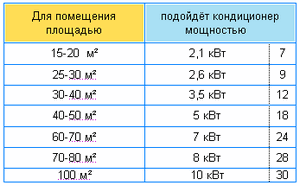 The power of the air conditioner determines the area of the room, the work in a certain temperature range, the direction and strength of the air flow.
The power of the air conditioner determines the area of the room, the work in a certain temperature range, the direction and strength of the air flow.
The English metric system was first adopted to determine the technical characteristics of air coolers. British thermal unit (BTU). The power of the equipment was 5,000, 7,000, 9,000, 12,000 BTU.Such a marking system has been preserved in many foreign companies. In the name of the equipment, the number indicates the cooling capacity of the model. If the marking is 09, then the model generates 9,000 BTU.
To choose a split system for the home, you should also consider the number of people living in the room and the presence of household or electronic equipment.
1 BTU = 0, 293 watts. For the air conditioner with designation 09, the power is 2.5 kW.
To calculate the power of the module, use the formula: TDP = power for cooling the volume of the room + power to compensate for the heat generated by people + power for cooling the heat flux created by the operation of household appliances.
The power needed to cool a certain volume of a room calculated as the volume of room X by the insolation coefficient (specific power required for 1 volume).
In various places, insolation has its own meaning.
| № | Room layout | Coefficient in W / m³ |
| 1 | North / Northeast side | 30 |
| 2 | East / West / Northwest | 35 |
| 3 | South / Southeast / Southwest Side | 40 |
The amount of heat coming from people, depends on physical activity. At rest, a person radiates 100 watts, with a large load - 150 watts. To calculate the power of an apartment air conditioner per room quadrature, proceed from the amount of heat released in a calm state. It is multiplied by the number of people.
To determine the heat from the equipment, constantly working devices are taken into account.
| № | Type of equipment | Heat generated in watts |
| 1 | A computer | 200 |
| 2 | TV | 300 |
| 3 | Other devices | 30% power consumption |
The sum of the obtained values will give the necessary power of the air conditioner for a medium-sized room with closed windows. To determine how many squares the split system 9 can cool the air, the initial data should be added.
When calculating the power of equipment for ventilated rooms take into account the increased load on the module. To the resulting amount add 20%.
Many manufacturers in the technical data sheet of the equipment indicate whether the air conditioner can work with open / ajar windows.
Air heating function
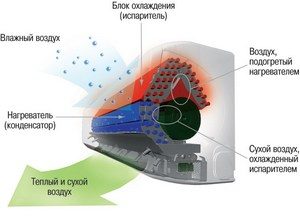 The possibility of heating is relevant in the off-season, with short-term temperature drops. Manufacturers of cooling equipment warn in technical data sheets that heating is carried out at an external temperature of not lower than - 15˚C. Long work in the “warm” mode will quickly disable the equipment, and besides, it will cost too much.
The possibility of heating is relevant in the off-season, with short-term temperature drops. Manufacturers of cooling equipment warn in technical data sheets that heating is carried out at an external temperature of not lower than - 15˚C. Long work in the “warm” mode will quickly disable the equipment, and besides, it will cost too much.
To switch to heating, the module setting switches from cooling to heating. The air conditioner works in the opposite direction. Thermal energy is taken from the outside air and transferred to the room.
Air conditioner energy efficiency
When choosing a split system for an apartment, attention is paid to the ratio of electricity consumed to power in cooling / heating the air. To do this, use the coefficients of energy efficiency (EER) and thermal conversion (COP). In the first case, cooling work is evaluated, in the second - heating. The higher the odds, the more efficient the air conditioner. For accessibility, an alphabetical classification of cooling systems has been created.
| № | Class | A | B | C | D | E | F | G |
| 1 | Eer | More than 3.2 | 3,0 – 3,2 | 3,0 – 2,8 | 2,8 – 2,6 | 2,6 – 2,4 | 2,4 – 2,2 | Up to 2.2 |
| 2 | COP | More than 3.6 | 3,4 – 3,6 | 3,4 – 3,2 | 3,2 – 2,8 | 2,8 – 2,6 | 2,6 – 2,4 | Up to 2.4 |
Energy efficiency factors were calculated in the laboratory. To choose the right split system, you need to consider dependence of work on the season, weather conditions. There are seasonal adjustment factors used by engineers to develop new models of equipment.
Permissible Noise Level
To determine the quality of operation of split systems, the level of noise created by them is taken into account. Despite the fact that the working unit is located outdoors, this indicator plays an important role in evaluating the cooling function of the air conditioner. The quieter the engine, the more comfortable the tenants feel at home.Sound measurement is in decibels. The less db the motor produces, the quieter the sound.
Sanitary standards set a maximum noise level of 34 dB. Most split air conditioners operate in a range not exceeding 30 dB.
Inverter models
Unlike conventional models, inverter air conditioners are more sensitive to temperature fluctuations. At the slightest changes in indicators, a command is automatically given to correct the power of work. With such a system, the equipment is constantly in operation. But by adjusting the power, energy savings are achieved.
Air filtration and treatment system
Air conditioners are equipped with a primary air filter. Periodically, it is removed and cleaned. Some models are equipped with filters for antibacterial purification of the flow. Manufacturers install bio-, cachetin, plasma filters that destroy fungal spores, mold, pathogens at the molecular level.
Some companies produce air conditioners with the function of air ionization. This technique saturates the room with negative ions, purified oxygen. Use this option carefully.
Modules with humidification function are popular. They feed clean, saturated air into the room.
Which air conditioner to choose for an apartment
Air conditioners make with a universal design, suitable for any environment. Usually it is white, clear rectangular shapes.
An important parameter is the distance from the outdoor unit to the indoor unit. The maximum value is 15 meters.
The market offers samples designed for all categories of consumers. Budget options, mid-range appliances, elite class air conditioners.
In split systems install automatic modesaffecting comfort and cost:
- Comfortable sleep - silent mode at low power.
- Wind - simulates the movement of air with a change of direction and intensity control.
- Saving.
- Air drainage.
- Enhanced mode - fast cooling.
- Self-diagnosis.
- Climate control.
Climate control systems are the most expensive.
When choosing a split system for an apartment, you should also pay attention to specifications:
- weight of blocks - external and internal;
- dimensions;
- temperature Range;
- area of the refrigerated space;
- noise level;
- power when heating.
The brand of the manufacturer is also important. On the one hand, a well-known company initially guarantees high quality of its equipment. On the other hand, you have to pay for the brand. Household appliances of popular companies are more expensive.
